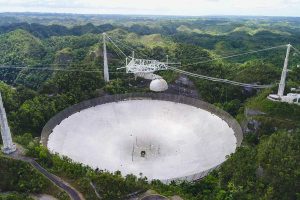
The Arecibo Observatory, as seen in 2019
A show of two halves, this month, starting with watery moons. One isn’t so surprising – Jupiter’s icy Europa. Known to have an ocean under the thick ice shell, models suggest that the plumes that have been observed may not be from the global reservoir, but from smaller briny pools within the icy crust.
The second moon is perhaps more surprising, being our own Moon. New measurements from the airborne observatory SOFIA have shown that there is molecular water within the rocks in some places on the surface, and not restricted to the permanently-shadowed craters. Lunar geologists Marissa Lo and Dr John Pernet-Fisher from the University of Manchester (and the Cosmic Cast podcast) explain why water on the moon is of so much interest. And what are we likely to learn when China’s Chang’e 5 mission brings samples back from the Moon later this year.
Moving further afield we return to Fast Radio Bursts – phenomena we’ve covered before a number of times on this podcast. We now have an example of a fast radio burst within our own galaxy, which is repeating its bursts. This gives us a great opportunity to study them in more detail.
We finish with some more somber news: the announcement that the beleaguered Arecibo telescope, jewel in the crown of the world’s radio astronomy and star of films such as Contact and Goldeneye, is to be decommissioned. Cardiff graduate Dr Rhys Taylor, who previously worked at Arecibo Observatory and regularly uses the telescope, explains quite how impressive the 300metre-diameter telescope is, and what an important role it has played in radio astronomy.
Contents
00:00 – Europa
05:05 – Water on the Moon
18:30 – Fast Radio Bursts
21:45 – Arecibo Telescope





